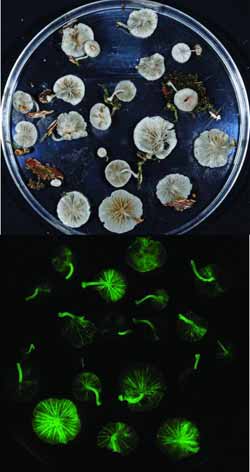7 new luminescent mushroom species discovered

A new luminescent fungus, Mycena silvaelucens, discovered by San Francisco State University Professor Dennis Desjardin and former SF State graduate student Brian Perry has been reported in the journal Mycologia. The species was collected in the grounds of an Orangutan Rehabilitation Center in Borneo, Malaysia and was found on the bark of a standing tree. The mushrooms are tiny with each cap measuring less than 18 millimeters in diameter. Credit: Brian Perry, University of Hawaii <br>
Reported today in the journal Mycologia, the new finds include two new species named after movements in Mozart's Requiem.
The discoveries also shed light on the evolution of luminescence, adding to the number of known lineages in the fungi 'family tree' where luminescence has been reported.
San Francisco State University Biology Professor Dennis Desjardin and colleagues discovered the fungi in Belize, Brazil, Dominican Republic, Jamaica, Japan, Malaysia and Puerto Rico. The discoveries include four species new to science and three new reports of luminescence in known species.
Three quarters of glowing mushrooms, including the species described in the study, belong to the Mycena genus, a group of mushrooms that feed off and decompose organic matter as a source of nutrients to sustain their growth.
“What interests us is that within Mycena, the luminescent species come from 16 different lineages, which suggests that luminescence evolved at a single point and some species later lost the ability to glow,” said Desjardin, lead author of the study. He believes that some fungi glow in order to attract nocturnal animals that aid in the dispersal of the mushroom's spores which are similar to seeds and are capable of growing into new organisms.
“It's pretty unusual to find this many luminescent species, typically only two to five percent of the species we collect in the field glow,” Desjardin said. “I'm certain there are more out there.”
The newly discovered fungi glow constantly, emitting a bright, yellowish-green light, and are tiny, with caps smaller than one centimeter across.
Desjardin has named two of the new species Mycena luxaeterna (eternal light) and Mycena luxperpetua (perpetual light), names inspired by Mozart's Requiem and the fact that these mushrooms glow 24 hours a day. To date, Desjardin has discovered more than 200 new fungi species and together with these latest findings, has discovered nearly a quarter of all known luminescent fungi.
“Luminescent Mycena: new and noteworthy species” was published online in the journal Mycologia on Oct. 5 and will appear in the March/April 2010 print issue. Co-authors include Brian A. Perry, former graduate student at San Francisco State University and currently of the University of Hawaii, D. Jean Lodge of the U.S. Forest Service, Cassius V. Stevani of the University of Sao Paulo, Brazil and Eiji Nagasawa of the Tottori Mycological Institute, Japan.
This research was supported by the National Science Foundation and the National Geographic Society.
Media Contact
More Information:
http://www.sfsu.eduAll latest news from the category: Life Sciences and Chemistry
Articles and reports from the Life Sciences and chemistry area deal with applied and basic research into modern biology, chemistry and human medicine.
Valuable information can be found on a range of life sciences fields including bacteriology, biochemistry, bionics, bioinformatics, biophysics, biotechnology, genetics, geobotany, human biology, marine biology, microbiology, molecular biology, cellular biology, zoology, bioinorganic chemistry, microchemistry and environmental chemistry.
Newest articles

After 25 years, researchers uncover genetic cause of rare neurological disease
Some families call it a trial of faith. Others just call it a curse. The progressive neurological disease known as spinocerebellar ataxia 4 (SCA4) is a rare condition, but its…

Lower dose of mpox vaccine is safe
… and generates six-week antibody response equivalent to standard regimen. Study highlights need for defined markers of mpox immunity to inform public health use. A dose-sparing intradermal mpox vaccination regimen…

Efficient, sustainable and cost-effective hybrid energy storage system for modern power grids
EU project HyFlow: Over three years of research, the consortium of the EU project HyFlow has successfully developed a highly efficient, sustainable, and cost-effective hybrid energy storage system (HESS) that…





















